The deadlift is a weight training exercise in which a loaded barbell or bar is lifted off the ground to the level of the hips, torso perpendicular to the floor, before being placed back on the ground. It is one of the three powerlifting exercises, along with the squat and bench press,[1] as well as a frequent lift in strongman.
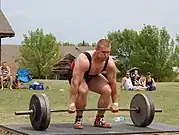
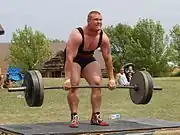
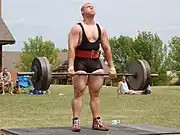
Two styles of deadlift are commonly used in competition settings: the conventional deadlift and the sumo deadlift.[2] While both of these styles are permitted under the rules of powerlifting, only the conventional stance is permitted in strongman.
Performing
Form

%252C_1.jpg.webp)
%252C_2.jpg.webp)
The conventional deadlift can be broken down into three parts: the setup, the initial pull or drive, and the lockout.[3]
Setup: When performing a deadlift, a lifter sets in a position that eccentrically loads the gluteus maximus, gluteus minimus, biceps femoris, semitendinosus and semimembranosus while the muscles of the lumbar contract isometrically in an effort to stabilize the spine.
- Set behind the bar with it nearly touching the legs (roughly 1 inch away from the shin), with feet turned slightly outwards.
- Begin by hinging at the hips and bending the knees, maintaining flat feet, let the shins move forward to touch the barbell but not push it away.
- Grip the bar outside of the legs, roughly at shoulder width. It helps with grip strength to grab the bar with one hand facing forwards and the other facing backwards.
- Raise the chest to position for a neutral spine, it is important to maintain a neutral spine throughout the lift.
- Pull the slack out of the barbell
Drive: The next section of the deadlift produces the greatest amount of force. By pushing down through their heels while simultaneously pushing up and forward with their hips and maintaining a depressed scapula and a long tense spine, an individual can remain safe during this motion. This is considered the most difficult part of the entire movement due to the amount of work required to drive the bar off the ground initially.
- Take a deep diaphragmatic breath and hold it in during the movement, creating an outward pressure on the core to further stabilize the lumbopelvic hip complex and core throughout the motion.
- Keep the muscles of the back contracted tightly in order to maintain a neutral spine throughout the motion.
- Drive up and forward with the hips and legs to stand erect and lift the bar.
Lockout: The finish is the most critical aspect of the motion. This requires being totally erect with a neutral spine and forceful hip extension to engage the muscles of the lumbar spine and abdomen in unison with the glutes.
- Drive the hips completely into the bar.
- Contract the glutei and the rectus abdominis to finish the movement with the pelvis in a neutral position. Contracting the glutes as well as the abdominal muscles is critical for lower back health and safety.
Lowering the weight: Performing the above steps in reverse order. As the muscles of the back and core must remain tight throughout the motion, one should simply hinge at the hips and knees to bring the weight down. Lowering the chest towards the knees while keeping the bar close is the safest way to complete the motion.
Common errors
There are a few common errors during the performance of the deadlift. Protracting the shoulders disengages the back muscles which stabilize the spine. Slack should be taken from the bar prior to the lift, by squeezing the back muscles first and straightening the arms; the bar should then be lifted in a smooth motion without jerking. As the objective of a deadlift is to hinge the hips, the knees should not be bent so deeply as to form a squat. If the bar is too far from the lifter, the lifter may compensate by rounding the back or shifting the weight to the front of the foot. Both result in shifting which muscles are used and could cause injury. Rounding the back in general is controversial; it is often recommended that during the lift, the back is flat with a spine neutral. Some lifters prefer to slightly round their back; but an excessively rounded back may result in the load being lifted awkwardly and placing too much stress or pressure on the back, which may lead to injury. The knees should be bent more fully on the descent of the bar to preserve a neutral spine.[4]
Weights
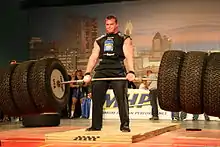
Deadlifts can be performed using dumbbells, barbells, or kettlebells with one hand or two hands, and with one leg or two legs. Other variations are the side deadlift or suitcase deadlift, rack pulls, deadlift lockouts, deficit deadlift or deadlift from a box (pulling from the floor while standing on a built or improvised low platform).[5]
Each of these variations is called for to address specific weaknesses in a lifter's overall deadlift. For instance, if the athlete has difficulty breaking contact at max weight, deficit deadlifts are performed to strengthen the gluteus maximus and hamstrings due to the greater range of motion required by standing on the low platform or low box. On the other hand, if the lifter has no problem with breaking contact with the floor but has difficulty locking out, they should perform rack pulls to strengthen their upper back, posterior deltoids, and trapezius muscles while de-emphasizing the gluteus and hamstrings.
Grips
Typically, there are three grips used: overhand (pronated), a mixed overhand-underhand (supinated) (sometimes called "offset," "staggered," "alternating", or "mixed") grip, or a hook grip. Depending on forearm strength, the overhand grip may result in the bar potentially rolling about. Mixed grip is capable of neutralizing this through the "physics of reverse torsion." The mixed grip allows more weight to be held for this reason.
In order to prevent the bar from rolling out of the hands, some lifters have been known to use an Olympic weightlifting technique known as the hook grip. This is similar to an overhand grip, but the thumbs are inside, allowing the lifter to "hook" onto them with the fingers. The hook grip can make it easier to hold heavier weights using less grip strength, and keeps both shoulders and elbows in a symmetrical position. While it theoretically takes much of the stress off the joints which might be created by the twisting of a mixed grip, it has the disadvantage of being extremely uncomfortable for the thumbs, something which those who advocate it says will pass once a lifter becomes accustomed to it. Another, but rarely used method is a combination of the mixed overhand-underhand grip and the hook grip, preferred by people who lift heavier weights than their grip can handle, but who don't want to rely on lifting straps or other supportive gear.
Many powerlifters adopt the overhand grip for their lower weight sets and move to the mixed grip to lift larger weights so they can achieve their one rep max.
A neutral grip can be achieved by the use of a trap bar; which is a hexagonal shaped bar which the lifter stands inside whilst holding the two side handles. The neutral grip provides the lifter with slightly different posturing which can help reduce the risk of injury.[6]
Muscles involved
A barbell deadlift is a compound exercise and works the gluteus maximus with further work on the quadriceps femoris, hamstrings, trapezius, lats, and erector spinae.[7] The quadriceps, hamstrings, adductor magnus, and soleus serve as synergists during the exercise.[7] For the powerlifting deadlift (where lifting straps are not allowed), the grip strength is also a decisive factor.
Deadlift variations
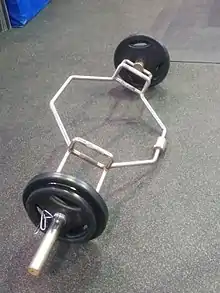
There are numerous variations of the deadlift.
Partial deadlift- This is where the range of movement (ROM) of the lift is reduced in order to train a particular part of it. Usually, this involves lifting from a higher starting position. This may be facilitated through the use of blocks or pins in a power rack. When considered in regard to the ROM of a normal deadlift, this means that the lift begins in a higher and stronger phase,[lower-alpha 1] avoids a lower and weaker phase, and thereby allows for more weight to be lifted. This can lead to increased strength gains.[10] A partial repetition deadlift may also only involve working in the lower weaker phase, in order to improve the amount if strength that can be applied there and help to overcome any sticking points.[11]
Single leg deadlift- This is a deadlift where one foot is on the ground and the other is raised. The grounded leg is primarily used to lift the weight and power the movement. The raised leg is roughly parallel with the straight grounded leg when the weight is lifted, and moves behind when the weight is lowered and the person bends over. As a unilateral, single leg exercise, it utilises the hips more so than if it was performed in a bilateral manner. It also means that the balance and core stability requirements are increased and this can lead to improvements in this regard.[12]
Trap bar deadlift- This involves the use of a trap bar (a.k.a. hex bar) which is a hexagonal or octagonal shaped bar which the user stands within. The handles are positioned at the side, which means that a neutral grip, with the palms of the hand turned inward, can be used. This alters the ROM of the lift and generally makes it less taxing on the lower back and reduces the risk of injury. Usually, there are two pairs of handles with one pair positioned higher, making the lift relatively easier, and the other lower, making the lift relatively harder.[13] The ROM of the trap bar deadlift means that a greater level of power can be generated in comparison to a traditional deadlift or squat. A similar exercise which also involves enhanced levels of power production is the trap bar jump i.e. a vertical jump while holding a trap bar.[14]
Equipment
A deadlift suit is a special piece of powerlifting assistance clothing. The suits are made from very tight material. The material tightens on the squat on the way down, storing energy, that gives an extra boost with the stored tension to lift up. Thus, records are recorded with and without the suit. The suits are also of two different types: single ply (one layer) and multi ply (two or more layers). The assistance increase as the number of layers increase. The starting position with a suit is slightly different to maximize use, so training with a suit is different. Wrist wraps are sometimes used to provide support, not necessarily to increase the weight lifted, as a suit does.[15]
Straps can help in a deadlift in case of a weak grip. Figure 8 straps are allowed in some strongman competitions. They allow the lifter to hold the bar in their fingertips and can reduce the distance travelled by over an inch.[16]
Chains and thick elastic bands can be attached to either end of the barbell in order to increase or decrease resistance at different phases of the lift. This is known as a variable resistance deadlift.
World Records
Men:
- Standard Bar Deadlift (with deadlift suit & straps) - 501 kg (1,105 lb) by Hafþór Júlíus Björnsson
 (2020)[17]
(2020)[17] - Standard Bar Raw Deadlift (no deadlift suit or straps) - 460.4 kg (1,015 lb) by Benedikt Magnússon
 (2011)[18]
(2011)[18] - Standard Bar Raw Sumo Deadlift (no deadlift suit or straps) - 487.5 kg (1,075 lb) by Danny Grigsby
 (2022)[19][20]
(2022)[19][20] - Elephant Bar Deadlift (Raw with straps) - 474.5 kg (1,046 lb) by Hafþór Júlíus Björnsson
 (2019)[21]
(2019)[21] - Hummer Tire Deadlift (from 15" height) (with deadlift suit & straps) - 549 kg (1,210 lb) by Oleksii Novikov
 (2022)[22]
(2022)[22] - Silver Dollar Deadlift (from 18" height) (with deadlift suit & straps) - 580 kg (1,279 lb) by Rauno Heinla
 (2022)[23]
(2022)[23]
Women:
- Standard Bar Deadlift (with deadlift suit & straps) - 317.5 kg (700 lb) by Lucy Underdown
 (2023)[24]
(2023)[24] - Standard Bar Deadlift (with deadlift suit & no straps) - 315 kg (694 lb) by Becca Swanson
 (2005)[25]
(2005)[25] - Standard Bar Raw Deadlift (no deadlift suit or straps) - 290.5 kg (640 lb) by Sara Schiff
 (2023)[26]
(2023)[26] - Standard Bar Raw Sumo Deadlift (no deadlift suit or straps) - 285.8 kg (630 lb) by Jessica Springer
 (2022)[27]
(2022)[27] - Elephant Bar Deadlift - 295.5 kg (651 lb) Raw by Tamara Walcott
 , with straps by Victoria Long
, with straps by Victoria Long  (2023)[28]
(2023)[28] - Hummer Tire Deadlift (from 15" height) (with suit & straps) - 363 kg (800 lb) by Andrea Thompson
 (2022)[29]
(2022)[29]
Notes
- ↑ A movement may be considered as having any number of strength phases but usually is considered as having two main phases: a stronger and a weaker. When the movement becomes stronger during the exercise, this is called an ascending strength curve i.e. bench press, squat, deadlift. And when it becomes weaker this is called a descending strength curve i.e. chin ups, upright row, standing lateral raise. Some exercises involve a different pattern of strong-weak-strong. This is called a bell shaped strength curve i.e. bicep curls where there can be a sticking point roughly midway.[9]
References
- ↑ Vaughan-Ellis, Nicolas (2013). "Introduction". Powerlifting: Training, Techniques and Performance. Ramsbury: The Crowood Press. ISBN 978-1-84797-575-1.
- ↑ Stoppani, Jim (2015). Jim Stoppani's Encyclopedia of Muscle and Strength (2 ed.). Champaign: Human Kinetics. p. 184. ISBN 978-1-4504-5974-7.
- ↑ Rippetoe, Mark (6 December 2011). "Ignorant When it Comes to Deadlifts?". T Nation. Retrieved 26 December 2020.
- ↑ DeWitt, Eric (26 April 2014). "Fix the 10 Most Common Deadlift Technique Mistakes". STACK. Retrieved 26 December 2020.
- ↑ Pearl, Bill (1979). Bill Pearl's Keys to the INNER Universe (1st ed.). United States: Bill Pearl. ISBN 1938855221.
- ↑ Waterbury, Chad (2022). "Trap Bar Deadlift". Elite Physique. Champaign: Human Kinetics. p. 94. ISBN 978-1-7182-0378-5.
- 1 2 Ketchum, Dan (1 July 2019). "What Muscles Does a Deadlift Work Out?". LIVESTRONG. Retrieved 26 December 2020.
- ↑ Calder, Alex & Centofanti, Adam (2023). "Exercise selection in soccer". Peak Performance for Soccer. Abingdon: Routledge. ISBN 978-1-003-20042-0.
{{cite book}}: CS1 maint: multiple names: authors list (link) - ↑ Stoppani, Jim (2015). Jim Stoppani's Encyclopedia of Muscle & Strength (3rd ed.). Champaign: Human Kinetics. pp. 38–39. ISBN 978-1-7182-1449-1.
- ↑ Sinicki, Adam (2020). "Heavy Partials". Functional Training and Beyond. Florida: Mango Publishing. ISBN 978-1-64250-504-7.
- ↑ Canadian Fitness Professionals (2023). Foundations of Professional Personal Training. Champaign: Human Kinetics. p. 390. ISBN 978-1-7182-1182-7.
- ↑ Cotter, Steve (2014). "Single-leg kettlebell deadlift". Kettlebell Training. Champaign: Human Kinetics. p. 102. ISBN 978-1-4504-3011-1.
- ↑ Brown, Jason (2023). Lower Body Training. Champaign: Human Kinetics. p. 116. ISBN 978-1-7182-0687-8.
- ↑ Calder, Alex & Centofanti, Adam (2023). "Exercise selection in soccer". Peak Performance for Soccer. Abingdon: Routledge. ISBN 978-1-003-20042-0.
{{cite book}}: CS1 maint: multiple names: authors list (link) - ↑ Harper, Devin. "Suits, Shirts, Wraps, and Sleeves: A Quick Tutorial on Powerlifting Gear". Breaking Muscle. Retrieved 26 December 2020.
- ↑ Beck, Kalle (18 February 2019). "Should An Elephant Bar Deadlift Record Count?". BarBend. Retrieved 26 December 2020.
- ↑ Guinness World Records (10 May 2020). "Heaviest Deadlift". guinnessworldrecords.com. Retrieved 25 March 2022.
- ↑ Strossen, Randall J. (3 April 2011). "Benedikt Magnusson: 460-kg Deadlift". IronMind. Retrieved 26 December 2020.
- ↑ "Danny Grigsby on openpowerlifting.com". Open Powerlifting. 2022-08-01. Retrieved 2022-08-01.
- ↑ Lockridge, Roger (2022-08-01). "Danny Grigsby (125KG) Sets All-Time World Record Raw Deadlift of 487.5 Kilograms (1,074.5 Pounds) at 2022 WRPF American Pro". BarBend. Retrieved 2022-08-01.
- ↑ Boly, Jake (3 March 2019). "Hafthor Bjornsson Deadlifts A 474kg Elephant Bar World Record (Closely Misses 501kg)". BarBend. Retrieved 26 December 2020.
- ↑ Lockridge, Roger (13 August 2022). "Strongman Oleksii Novikov Pulls 1,210 Pounds For New Hummer Tire Deadlift World Record". BarBend. Retrieved 13 August 2022.
- ↑ Cite web url=https://barbend.com/rauno-heinla-world-record-silver-dollar-deadlift-580-kilograms/
- ↑ "Lucy Underdown deadlifts 700lbs for a new deadlift world record". startingstrongman.com. 2 September 2023. Retrieved 3 September 2023.
- ↑ "Becca Swanson (F)". Openpowerlifting.org. 5 November 2005. Retrieved 6 Mar 2023.
- ↑ "Sara Schiff (F)". Openpowerlifting.org. 5 July 2023. Retrieved 21 July 2023.
- ↑ "Jessica Springer (F)". Openpowerlifting.org. 9 April 2022. Retrieved 21 July 2023.
- ↑ "Rogue Record Breakers - Day 3 - Livestream". Rogue.com. 5 March 2023. Retrieved 6 March 2023.
- ↑ Smith, Andrew (5 March 2022). "2022 Arnold Pro Strongwoman Results". fitnessvolt.com. Retrieved 21 May 2022.
Further reading
- Mark Rippetoe with Lon Kilgore, Starting Strength, The Aasgaard Company Publishers, 2005, ISBN 0-9768054-0-5
- Frédéric Delavier, Strength Training Anatomy, Human Kinetics, 2001, ISBN 0-7360-4185-0